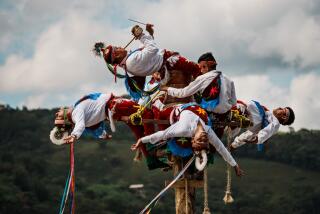Caught Up in Pelota
- Share via
Lake View Terrace — On a parched field near Hansen Dam, about a dozen men gather under a blazing sun to play a ritual ball game handed down to them by their ancient Aztec forefathers. It is pelota Mixteca.
This match pits the San Fernando home team against a team from Santa Barbara.
Team members tape their hands and put on guantes, oversize mitts made of thick leather with hundreds of nails driven into them. The gloves, which can weigh anywhere from 6 to 21 pounds, have been painstakingly custom-made for each player in Mexico City.
The players walk out onto the 300-by-25-foot, grass-less field marked by lines dug into the dry dirt. A rock at centerfield marks the spot where a 2-pound, softball-sized rubber ball is served.
Five members of Team San Fernando line up-two players in the front row and three in back-to face their opponents.
The San Fernando server bounces the ball once and whacks it with his glove toward the other team. The ball, which can reach speeds of 60 to 70 mph, takes a high bounce and is returned.
The volley continues under the watchful eye of teh chasero, the judge, who calls balls in or out and settles disputes between players. If a player is unable to a ball or if it is hit out of bounds, a point is scored.
No one knows for sure when the Aztec Indians first began to play pelota games, of which there are at least 14 different versions.
Archeologists have excavated rubber balls estimated to be 3,000 years old.
In ancient times the game had a spiritual aspect, archologists say. Players believed they could enter the afterlife just by participating.
Pelota Mixteca is played primarily in Mexico City. Immigrants brought the game to California.
Now, on many Sundays at Hansen Dam, men gather to play, celebrating a rich culture and, for a fleeting moment, bridging the divide between past and present.
More to Read
Go beyond the scoreboard
Get the latest on L.A.'s teams in the daily Sports Report newsletter.
You may occasionally receive promotional content from the Los Angeles Times.










